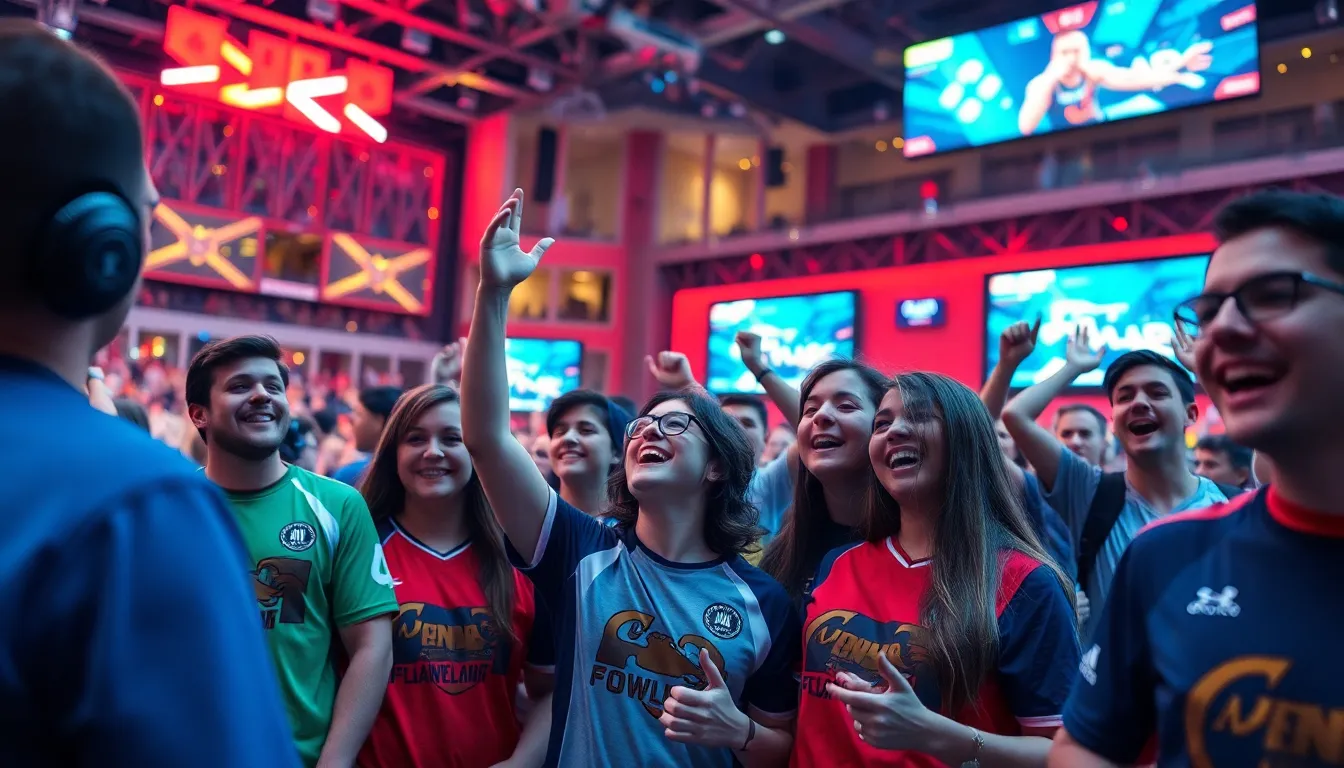In a world where gaming isn’t just a pastime but a full-blown spectacle, esports coverage has become the new arena for excitement. Forget traditional sports; it’s time to level up and dive into the electrifying realm of competitive gaming. With millions glued to their screens, the buzz around esports is louder than a victory scream after a nail-biting match.
But what makes esports coverage so captivating? It’s not just about watching players click their way to glory; it’s about the drama, the strategy, and yes, the occasional meme-worthy moment that leaves viewers in stitches. From heart-stopping tournaments to in-depth analysis, the esports scene offers a thrilling mix of entertainment and insight. So grab your snacks and settle in; this is where passion meets pixels, and every match is a story waiting to unfold.
Table of Contents
ToggleWhat Is Esports Coverage?
Esports coverage involves broadcasting competitive video gaming events, showcasing both gameplay and commentary. It attracts millions of viewers worldwide. Many fans enjoy live streaming platforms, where they follow their favorite teams and players in real-time. Live coverage includes streams, highlights, and analysis, enhancing the overall experience.
Various media outlets provide esports coverage, including dedicated websites, social media channels, and television networks. Each platform caters to different audiences. For example, Twitch focuses primarily on live streaming, whereas YouTube offers both live and recorded content.
Commentators play a vital role in esports coverage. Their insights engage viewers, explaining strategies, moves, and player decisions. By offering context, they help audience members understand the game better. In turn, this makes the experience more thrilling for viewers, deepening their connection to the matches.
Data analytics has also become significant in esports coverage. Statistics provide insights into player performance, match history, and team strategies. Analyzing this data helps fans and analysts make informed predictions about future matches. As a result, the data-driven approach amplifies viewer involvement.
Esports tournaments often feature exciting storylines. From rivalries to comeback victories, each match carries its narrative. Fans appreciate these elements, which build anticipation for upcoming events. Consequently, coverage of esports expands beyond just the live action, creating a richer context for every game played.
Importance Of Esports Coverage

Esports coverage holds significant value in the landscape of competitive gaming. It shapes the way fans interact with their favorite games and players.
Impact On Viewership
Viewership for esports continues to grow exponentially, with millions tuning in globally. In 2023, esports attracted over 500 million viewers, underscoring its rising popularity. Fans engage with live events through streaming platforms such as Twitch, where interaction enhances the viewing experience. Platforms also serve diverse content, including highlights, analysis, and commentary, which cater to various audience preferences. Each broadcast showcases not just gameplay but also the narratives and rivalries that captivate viewers. This interaction fosters a sense of community among fans, amplifying their loyalty to teams and players.
Effects On Sponsorships
Sponsorships represent a critical financial component for esports. Brands increasingly recognize the opportunity to connect with the massive audience. In 2023, esports sponsorship revenue reached approximately $1.3 billion, reflecting substantial growth. Companies targeting younger demographics find value in associating with popular teams and events. Sponsorships extend beyond traditional ads, often involving partnerships for promotional activities and product integrations. This synergy benefits brands and esports organizations, enhancing visibility and revenue streams. The evolving landscape of sports marketing continues to spotlight esports as a viable platform for engagement.
Types Of Esports Coverage
Esports coverage encompasses various formats that cater to different audience preferences. Notably, live streaming platforms and traditional media play essential roles in broadcasting competitive gaming events.
Live Streaming Platforms
Live streaming platforms like Twitch and YouTube transform the way fans engage with esports. They provide real-time broadcasts of matches, allowing viewers to connect with their favorite players instantly. Interaction remains a key feature, with chat functions enabling direct communication between fans and commentators. Engagement through features such as subscriptions and donations helps support content creators and teams effectively. In 2023, Twitch captured a significant share of the esports viewership, attracting millions of concurrent users worldwide. YouTube, meanwhile, offers a mix of live streaming and recorded content, ensuring fans can consume esports in various ways.
Traditional Media Involvement
Traditional media involvement in esports coverage continues to expand, reaching broader audiences beyond online platforms. Networks like ESPN and TBS feature esports tournaments on their channels, elevating the visibility of competitive gaming. Coverage includes not just live matches but also documentaries and highlights that deepen viewer understanding. Such exposure contributes to a growing acceptance of esports within mainstream sports culture. Additionally, partnerships with traditional sports teams and leagues further integrate esports with established formats. In 2023, this approach enhanced viewership, bridging the gap between conventional and digital audiences.
Challenges In Esports Coverage
Esports coverage faces several significant challenges that affect its growth and quality.
Issues With Regulation
Regulatory issues arise due to the diverse nature of esports. Different regions have varying laws regarding gambling, age restrictions, and competition standards. Unclear guidelines can hinder tournament organization and player participation. Organizations like the Esports Integrity Commission work to establish best practices, but inconsistency remains prevalent. As esports continues to gain traction, regulatory bodies must adapt quickly to keep pace with this fast-moving industry. Compliance with emerging regulations ensures a fair and safe environment for participants and audiences alike.
Quality Of Commentary
Quality of commentary plays a crucial role in enhancing the viewer experience. Engaging commentators provide insights and context that elevate gameplay appreciation. Nevertheless, inconsistencies in commentary quality can frustrate fans. Some commentators lack sufficient knowledge or experience, affecting the depth of analysis. Training programs and professional development for commentators can improve overall standards. High-quality commentary attracts and retains viewers, ultimately driving the growth of esports coverage. Balancing entertainment and information is essential for commentators to connect with audiences effectively.
Future Trends In Esports Coverage
Esports coverage continues to evolve rapidly, driven by innovations in technology and viewer engagement. Streaming platforms are integrating enhanced interactive features, allowing fans to participate in real-time polls and discussions. Live event experiences aim to replicate traditional sports, introducing augmented reality elements that enrich spectator immersion.
As analytics mature, data-driven storytelling will become more prominent in broadcasts. Statistics on player performance and strategy patterns will guide commentary, making insights clearer for casual viewers. AI technology increasingly plays a role in content personalization, tailoring viewing options based on user preferences and behavior.
Additionally, mobile esports coverage is gaining traction. With over 2.5 billion mobile gamers globally in 2023, events focused on mobile games attract substantial audiences. These broadcasts often include real-time matchmaking, appealing to viewers’ desire for instant gratification and immediate engagement.
Partnerships between esports organizations and traditional media outlets will advance further. Large networks like ESPN and traditional sports leagues plan to feature more esports content, blurring lines between conventional sports and gaming. This collaboration promotes broader acceptance of esports in mainstream culture.
Regulatory advancements continue to impact the landscape. Bodies like the Esports Integrity Commission are striving to implement standardized regulations, enhancing credibility. Improved standards in commentary quality also shape viewer satisfaction, as better-trained commentators engage audiences more effectively.
Sponsorships are projected to remain a crucial financial driver. Brands increasingly seek partnerships that leverage esports’ growing viewership, particularly among youth demographics. The total esports revenue, approximately $1.3 billion in 2023, reinforces the importance of strategic brand alignments in the industry.
Esports coverage is evolving into a multifaceted phenomenon that captivates millions around the globe. The blend of strategy drama and fan engagement creates a unique viewing experience that continues to attract diverse audiences. As technology advances and traditional media embraces this dynamic landscape the future of esports coverage looks promising.
With increasing viewer interaction and innovative formats the connection between fans and players deepens. Challenges remain but the commitment to improving commentary standards and regulatory practices will only enhance the credibility of the industry. As esports carve out its place in mainstream culture the excitement surrounding competitive gaming is sure to grow even further.



